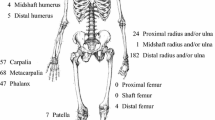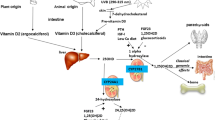Abstract
Background
Patella fractures have not traditionally been considered “fragility” fractures.
Questions/Purpose
The purpose of this study was to examine the demographic patterns (age and gender distribution) and plasma 25-hydroxyvitamin D levels of a cohort of patients with operative patella fractures.
Patients and Methods
Medical records were reviewed on all consecutive patients presenting to our institution with operative patella fractures from 2003 to 2009. Seventy-eight operative patella fractures (25 male, 53 female) were identified with a mean age of 58 years (range, 22–89 years).
Results
The majority of patients with patella fractures in this series were females over the age of 50 years who sustained low-energy falls from a standing height or less. Twenty-four patients (80%) had vitamin D insufficiency or deficiency at the time of injury. For 68 patients (87%), the patella fracture represented their first fracture. Patients with known osteoporosis risk factors did not have higher rates of vitamin D insufficiency/deficiency.
Conclusions
The age and gender distribution, as well as the prevalence of vitamin D insufficiency/deficiency, of operative patella fractures, suggest that these patients likely have abnormal vitamin D levels and should undergo a metabolic bone work-up.

Similar content being viewed by others
References
Borgstrom F, Zethraeus N, Johnell O, et al. Costs and quality of life associated with osteoporosis-related fractures in Sweden. Osteoporos Int. 2006;17(5):637–650.
Brinker MR, O’Connor DP, Monla YT, et al. Metabolic and endocrine abnormalities in patients with nonunions. J Orthop Trauma. 2007;21(8):557–570.
Bukata SV, Kates SL, O’Keefe RJ. Short-term and long-term orthopaedic issues in patients with fragility fractures. Clin Orthop Relat Res. 2011;469(8):2225–2236.
Collinge C, LeBus G, Gardner MJ, et al. Osteoporosis in orthopaedic trauma patients: a diagnosis and treatment protocol. J Orthop Trauma. 2008;22(8):541–547. discussion 548–9.
Dawson-Hughes B, Mithal A, Bonjour JP, et al. IOF position statement: vitamin D recommendations for older adults. Osteoporos Int. 2010;21(7):1151–1154.
Eknoyan G. Adolphe Quetelet (1796–1874)—the average man and indices of obesity. Nephrol Dial Transplant. 2008;23(1):47–51.
Gass M, Dawson-Hughes B. Preventing osteoporosis-related fractures: an overview. Am J Med. 2006;119(4 Suppl 1):S3–S11.
Johnell O, Kanis JA. An estimate of the worldwide prevalence and disability associated with osteoporotic fractures. Osteoporos Int. 2006;17(12):1726–1733.
Kanis JA. Diagnosis of osteoporosis and assessment of fracture risk. Lancet. 2002;359(9321):1929–1936.
Kanis JA, Oden A, Johnell O, et al. The burden of osteoporotic fractures: a method for setting intervention thresholds. Osteoporos Int. 2001;12(5):417–427.
Leboff MS, Kohlmeier L, Hurwitz S, et al. Occult vitamin D deficiency in postmenopausal US women with acute hip fracture. JAMA. 1999;281(16):1505–1511.
Melhus H, Snellman G, Gedeborg R, et al. Plasma 25-hydroxyvitamin D levels and fracture risk in a community-based cohort of elderly men in Sweden. J Clin Endocrinol Metab. 2010;95(6):2637–2645.
Meunier P. Prevention of hip fractures by correcting calcium and vitamin D insufficiencies in elderly people. Scand J Rheumatol Suppl. 1996;103:75–78. discussion 79–80.
NIH Consensus. Development Panel on Osteoporosis Prevention, Diagnosis, and Therapy. Osteoporosis prevention, diagnosis, and therapy. JAMA. 2001;285(6):785–795.
Nuti R, Martini G, Valenti R, et al. Vitamin D status and bone turnover in women with acute hip fracture. Clin Orthop Relat Res. 2004;422:208–213.
Oyen J, Brudvik C, Gjesdal CG, et al. Osteoporosis as a risk factor for distal radial fractures: a case–control study. J Bone Joint Surg Am. 2011;93(4):348–356.
Sontag A, Krege JH. First fractures among postmenopausal women with osteoporosis. J Bone Miner Metab. 2010;28(4):485–488.
Stegman MR, Davies KM, Heaney RP, et al. The association of patellar ultrasound transmissions and forearm densitometry with vertebral fracture, number and severity: the Saunders County Bone Quality Study. Osteoporos Int. 1996;6(2):130–135.
Van Schoor NM, Visser M, Pluijm SM, et al. Vitamin D deficiency as a risk factor for osteoporotic fractures. Bone. 2008;42(2):260–266.
World Health Organization. Assessment of fracture risk and its application to screening for postmenopausal osteoporosis. 1994.
Acknowledgments
The authors would like to thank Huong Do, MA for designing and performing the statistical analysis for this study.
Disclosures
Each author certifies that he or she has no commercial associations (e.g., consultancies, stock ownership, equity interest, patent/licensing arrangements, etc.) that might pose a conflict of interest in connection with the submitted article. One or more of the authors have or will receive monies from a commercial entity that may be perceived as a potential conflict of interest. One or more of the authors’ institution has or will received monies from a commercial entity that may be perceived as a potential conflict of interest.Each author certifies that his or her institution has approved the reporting of these cases, that all investigations were conducted in conformity with ethical principles of research.
Author information
Authors and Affiliations
Corresponding author
Additional information
Level of Evidence: Level IV: Prognostic Study.
Rights and permissions
About this article
Cite this article
Reinhardt, K.R., Lazaro, L.E., Umunna, BP. et al. Plasma 25-Hydroxyvitamin D Levels in Operative Patella Fractures. HSS Jrnl 9, 17–20 (2013). https://doi.org/10.1007/s11420-012-9324-6
Received:
Accepted:
Published:
Issue Date:
DOI: https://doi.org/10.1007/s11420-012-9324-6




